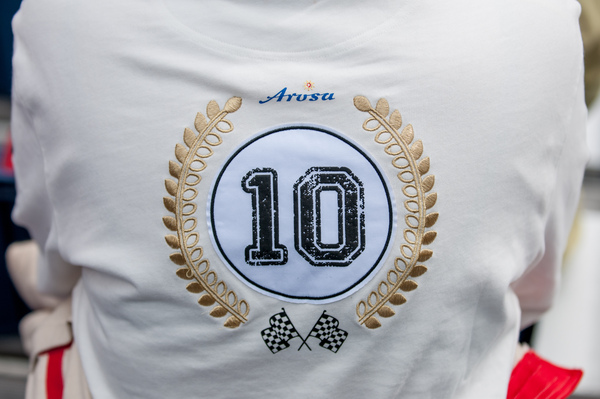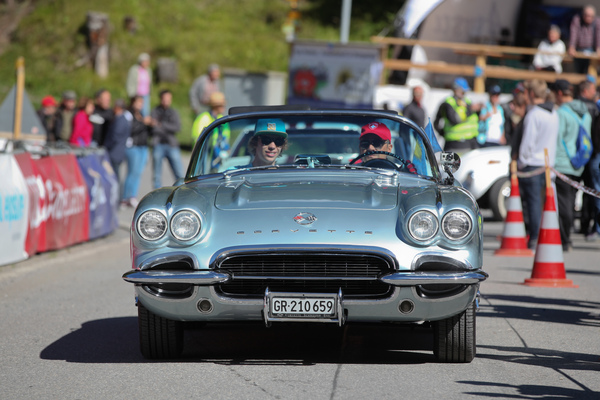Have you seen the movie "Groundhog Day"? Bill Murray plays a man who relives the same day over and over again. Exactly the same way, without any nuances. Perhaps that's how it felt for the visitors and participants of the Arosa ClassicCar Hill Climb 2014.
Somehow, everything seemed very familiar. Many of the drivers and vehicles had already competed in previous events, and seven of them had even taken part in each of the ten races: Benno Allemann, Tom Becvarik, Roman Becvarik, Marcel Hayoz, Peter Keller, Urs Schweinfurth and Jürg Tobler. They didn't miss a single race, experiencing the 7.8 kilometers from Langwies to Arosa in snowfall, rain and sunshine.
It makes sense for Arosa ClassicCar to rely on the tried and tested, which in this case is the fascinating hill climb route with a length of almost eight kilometers and 76 bends, as well as a 1.2 km long descent in the middle of the route, which is rare for hill climbs.
The weather was once again the usual mix of rain, fog and sun. As in previous years, the weather improved over the course of the weekend, and on Sunday it was flattering with a steel-blue sky and rising temperatures.
Back to the movie quoted at the beginning: a long-sleeping marmot would of course hardly have greeted the thundering V8 engines and high-speed four-cylinders in a friendly manner. But the symbol of Arosa is not the marmot, but the ibex. And the ibex is known to be a goat relative that loves to climb. This makes it a perfect match for the Arosa Hill Climb, where light and agile cars in particular can show off their advantages.
Ten-year anniversary
More than ten years ago, none of the founders of the Langwies-Arosa hill climb would have thought that it would become such a tradition. Back then, Peter Müller, Martin Häfeli and Koni Strittmatter were talking at a hotel bar about how to organize a historic race in Schanfigg. They quickly sketched out and developed a rough concept. Pepe Hammerer and Beni Burger were brought on board and the first hill climb was organized in 2005 under the name "International Arosa Classic Car". And it even made it onto Swiss national television and the program "Glanz & Gloria".
Over time, the organization and patronage changed, but the joy of driving fast on the natural mountain race track remained. To this day, cars are driven at top speed and Arosa ClassicCar is the only Swiss event in the historic sector that manages to do this every year.

Entry record
It didn't look like it at first, but in the end the tenth event managed to set an entry record. In the racing category alone, 38 vehicles were counted. This can also be seen as a success and the result of many years of development work.
Arosa instead of Goodwood
For once, Arosa ClassicCar did not appear on the calendar this year in competition with the F1 Monza Grand Prix, but with the English Goodwood Revival racing event. This caused the organizers a few headaches, as it meant that some drivers were not in Switzerland with their cars on the second weekend in September.
In the end, it was possible to lure some vehicles that would probably have looked good at Goodwood to the start in Langwies, including a Cobra with a particularly impressive palmares. Chassis CSX 2301 competed in the 1964 12 Hours of Sebring with Bob Bondurant and L. Spencer at the wheel, finishing 5th overall and 2nd in the GT class. This was followed by participations in the Targa Florio (retirement), 1000 km Nürburgring and the Freiburg-Schauinsland and Sierre-Montana hill climbs (both with Jochen Neerpasch at the wheel).
In 1965, the car competed several times at Goodwood, Spa and even at the 24 Hours of Le Mans. There is hardly another Cobra with such a racing history. The car was used as a works "team car". Many famous drivers such as Attwood, Schlesser, Frère, Bondurant and Sparrow took the wheel of this famous Cobra.
However, the potent Cobra was unable to take part in the race for the fastest times, as the rare car was probably too valuable to its owner.
The battle for the fastest time
The three best times from four races determined the overall winner of the Arosa ClassicCar 2014 - a good arrangement for local driver Roger Moser. His 1980 Martini Mk 28/T02 Formula 2 car had only just been completed before the hill climb, and Moser had barely had a chance to get used to the car. During the first training runs, he was amazed at the short braking distances and the driving dynamics, which were so different from the touring cars he had chased up the mountain in the past. "In some places I have to accelerate again after braking before the corner, the brakes are so short," said Moser. But by the second race run in the dry, he had this under control and clearly demonstrated the superiority of his car with times under 4:30 minutes.
Last year's winner Armin Zumtobel was also unable to keep up with the fast Formula 2, but drove masterfully consistently on Sunday. His two times in dry weather differed by just eight hundredths of a second.
Duschi B. Duschletta also made it onto the podium in third place overall thanks to consistent times. The three fastest overall were also group winners, as they each competed in different categories.
Toni Seiler was unable to take part in the battle for overall victory with his powerful Le Mans Lola T 70 Mk 3 from 1968, as its gear ratio was probably too long for the mountain and even back then the V8 Lolas hardly ever came to the fore in mountain races. Nevertheless, with a Saturday time of 4:37, he showed that the three ahead of him could by no means take it easy.
The steady ones
Not only the Competition class was fast, but also the riders who were measured for consistency. The fact that the standard time had to be set in the rainy race on Saturday was of course suboptimal, especially for those who drive most consistently at the limit.
However, Dani Müller, who competed in the 1964 Abarth 1000 TC Corsa instead of his usual 300 SL 2014, was hardly bothered by this. He enjoyed the agile handling of the Bergfloh and improved his time to 5:28, although this did not make him the fastest in the Arosa Classic Trophy, as some of the cars came surprisingly close to the five-minute mark.
Hanno Mayr in a 1971 Lancia Fulvia 1.3 S proved to be the most consistent, however, finishing the test with a difference of just 11 hundredths.
The elimination stage of the Arosa Sport Trophy was even faster in places, with Patrik Herzig in his 1973 Porsche 911 RSR 2.8 also looking good in the Competition class with a time of 4:29:06. However, his hunt for fast times did not lead to small time gaps between the two best runs.
In this criterion, another man did much better. Frank Gassmann, driving a 1959 Austin-Healey 3000 MK 1, managed to set his two best times with a difference of just three hundredths.

Lots of spectators
The beautiful Sunday weather in particular attracted many spectators to Arosa in 2014. The queues of cars from Chur to Arosa grew to several kilometers during the course closures. In the village of Arosa and also in Litzirüti, many enthusiastic classic car fans applauded and greeted the 180 or so cars. The organizers counted around 25,000 spectators over the four days, so the tenth edition of Arosa ClassicCar proved to be a success here too.
Not entirely without incident
Racing is never without danger and there were also a few accidents in 2014, but thankfully all of them were minor, even if expensive material was damaged. On Saturday, one of the Porsche 911s skidded off the top part of the track on a semi-moist road, while one of the DTM BMW M3s had already caused a fender bender in the demo field. Despite the mishaps, there were no excessive delays to the schedule.
Coherent concept
Looking back, the new concept with the paddock moved to the front of the finish area and the more sheltered hospitality area can be seen as a success. Although the organization struggled with the floods of water, which of course could hardly be removed from the "ice field", the advantages of the simpler logistics outweighed the disadvantages, so that next year, when the Arosa ClassicCar hill climb takes place from 3 to 6 September 2015, it will probably be possible to build on the same concept again.
And what about this marmot? Well, in the movie, Bill Murray got quite used to living the same day over and over again and he eventually learned to play the piano, among many other skills that he continued to develop. And it's the same with the participants in the Arosa ClassicCar hill climb. They get a little faster and/or more consistent every year ....

































































































































































































































































